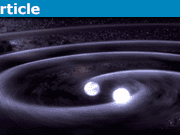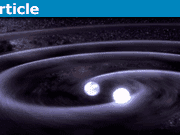Understanding the General Relativity View of Gravity on Earth
Often students have difficulty reconciling the General Relativity (GR) view of gravity versus their own experience with gravity on the surface of Earth. This article covers some of the basic concepts and explains how they work with “every day” gravity.
Table of Contents
Important Concepts
- Spacetime: the combination of 3 dimensions of space and 1 dimension of time into a unified 4D “manifold”.
- Coordinate systems: mappings between events in spacetime and 4 numbers called coordinates. Usually, the coordinates involve a 1-time coordinate and 3 spatial coordinates.
- Proper acceleration: the acceleration measured by an ideal accelerometer. This is the acceleration that you physically “feel”.
- Coordinate acceleration: the 2nd derivative of position in some given coordinate system.
- Inertial frame: a coordinate system where inertial objects have no coordinate acceleration. In inertial frames, the line formed by an inertial object’s coordinates is a straight line.
- Curvature: when a surface is not flat, for example, the surface of a sphere. The geometry is different in curved manifolds versus flat ones. For instance, the angles in a triangle may not sum to ##\pi##.
Non-inertial Frames and Fictitious Forces
Physics is traditionally taught using inertial frames, however, there is no restriction that prevents the use of non-inertial frames (e.g. a rotating reference frame). In a non-inertial frame inertial objects undergo coordinate acceleration, and in order to use Newton’s 2nd law in such frames additional “fictitious forces” (e.g. the centrifugal and Coriolis forces) are introduced.
These fictitious forces all share a few properties:
- They are proportional to the mass of the object
- They cannot be detected by an accelerometer
- They disappear in inertial frames
The Force of Gravity: Newton vs. Einstein
In Newtonian mechanics, gravity is considered to be a real force, even though it shares the first two properties of fictitious forces listed. This makes Newtonian gravity a bit of a strange force. You cannot determine if a given reference frame is inertial or not simply by using accelerometers, you have to additionally know the distribution of mass nearby to correct your accelerometer readings for the presence of gravity.
In GR, this is simplified by considering gravity to be a fictitious force just like any other force which is proportional to the mass and cannot be measured by an accelerometer. This means that in GR an apple in free fall to the ground is considered to be inertial, while in Newtonian gravity the apple is non-inertial. Similarly, the rest frame of the free-falling apple is an inertial frame in GR with no fictitious forces, while in Newtonian mechanics it is a non-inertial frame with a fictitious force that is equal and opposite to the force of gravity.
The Apple Falling
As mentioned above, an apple freely falling to the ground is considered to be inertial in GR. If we make a coordinate system where the apple is at rest, it is an inertial coordinate system. In this reference frame, the apple does not accelerate, instead, the ground accelerates upwards at g and slams into the apple. This corresponds to the fact that an accelerometer attached to the apple reads 0, while an accelerometer attached to the ground reads 1 g upwards.
This is a bit odd. What is causing the ground to accelerate?
If you draw a free-body diagram of a small section of the ground, you find that there is a rather large real upward pressure force on the bottom of the section, and this upward pressure is not balanced by a corresponding large downward pressure on the top. Therefore, there is a net upward force on the ground, which is responsible for the upward acceleration. Although this seems like a strange way to think, at first, it is clear that this approach still accounts for whether or not the apple splatters when it hits the ground, and so forth.
Spacetime Geometry
Now consider a “spacetime diagram” of the apple, where time is plotted on one axis and the apple’s vertical position is plotted on the other axis. In such a diagram the apple can be represented by a line (called a “worldline”) which shows its position at each point in time. If we take the frame where the apple is at rest then the apple travels along a straight line which is parallel to the time axis. A second apple that started free-falling a moment earlier or later would have some constant velocity relative to the first apple, so its worldline would also be a straight line, but not parallel to the time axis.
So objects at rest relative to each other have parallel worldlines while objects that are moving relative to each other have non-parallel worldlines. Similarly, objects at rest relative to a reference frame have worldlines that are parallel to the time axis.
Now, consider a point on the ground. This point is initially at rest relative to the apple (and therefore the reference frame), so its worldline starts out parallel to the time axis. However, by the time the ground collides with the apple, it has gained some relative velocity and is no longer parallel. In other words, the ground’s worldline is curved.
So inertial objects (accelerometer reads 0) have straight worldlines while non-inertial objects have worldlines that are curved in a direction and by an amount given by their proper acceleration.
Curved Spacetime and Tidal Gravity
While this is all well and good for a single apple falling in a uniform gravitational field, what happens when we consider tidal gravity (gravity that varies over space) such as two apples falling on opposite sides of the world?
Let’s suppose that there is a hole completely through the Earth and no atmosphere so that we can neglect the ground and the air (let’s also neglect the rotation of the Earth). In this case, the two apples will start on opposite sides of the Earth and eventually collide when they reach the middle. When they start they will be at rest relative to each other, and when they collide they will have a considerable velocity relative to each other.
How can that work with our spacetime view? We already established that being at rest means that their worldlines are parallel, and having relative velocity means that their worldlines are not parallel. So the two apples’ worldlines start parallel and then wind up non-parallel. However, we also established that having 0 proper acceleration (i.e. being inertial and having 0 accelerometer reading) means that the worldline is straight. So both apples’ worldlines are straight. How can we reconcile the straight worldlines with the fact that they go from being parallel to intersecting? The answer is that in the presence of tidal gravity spacetime is curved, not flat.
A straight line in curved space is called a geodesic, for example, a great circle is a geodesic on the surface of a sphere. A longitude line is a great circle, and therefore a geodesic. Consider two nearby longitude lines at the equator they are parallel but at the pole they intersect, despite being everywhere straight. So curved spaces have the necessary geometric properties.
Using this idea of curved spacetime, we can describe how the two apples can have 0 proper acceleration everywhere (straight worldlines) and yet accelerate relative to each other (initially parallel, but later intersecting). However, this has some consequences. The most critical is that there is no longer any such thing as an inertial frame that covers both apples, inertial frames are now “local” meaning that you can only use them when tidal effects are negligible (spacetime curvature is negligible).
The Surface of the Earth
In the previous section we neglected the ground, but now let’s consider the ground. If the ground is accelerating upwards and the direction corresponding to “up” changes around the globe, then it seems that the surface of the Earth should be expanding, with the distance from one point to another continually increasing.
This reasoning is incorrect in curved spacetime. In flat spacetime, it would be correct that the surface of the Earth could not be accelerating (proper acceleration) outwards while retaining a constant radius, but spacetime is curved so it can indeed accelerate (proper acceleration) outwards while retaining a constant radius.
To understand the importance of curvature, consider two latitude lines on a sphere. For simplicity consider the latitude lines 5° N and 5° S. As you follow those lines around the sphere, they maintain a constant distance from each other. However, the 5° N line is constantly turning to the north and the 5° S line is constantly turning to the south. So they are turning away from each other but maintaining a constant distance. This is impossible on a flat surface, but possible on a curved surface.
In the geometry of the spacetime around the Earth (i.e. Schwarzschild spacetime) you can take any two points on the surface of the Earth and find that they are accelerating (covariant derivative = proper acceleration) in different directions, and yet, because the spacetime is curved, the distance between them does not change (e.g. as measured by radar).
Summary and Key Points
- In GR the force of gravity is considered to be a fictitious force, and inertial reference frames are free-fall frames where falling apples have straight worldlines and the ground continuously accelerates upwards at g.
- In order to model tidal gravity (where gravity varies from location to location), we must use curved spacetime.
- This allows for two apples to each have straight (geodesic) worldlines but still, accelerate relative to each other.
- It also allows for the ground to continuously accelerate upwards without the Earth expanding.
- However, it means that you cannot make an inertial frame that covers the whole Earth, and so inertial frames are only local.
Education: PhD in biomedical engineering and MBA
Interests: family, church, farming, martial arts








[QUOTE=”PAllen, post: 5191239, member: 275028″]
My read is different from yours. The frame is based on a world line not a body of any kind (test or otherwise). The center of the earth is perfectly ok. Nothing in their derivation restricts the world line to being in vaccuum (any mix of Weyl and Ricci curvature is accommodated by their construction).[/QUOTE]
Ok, so I guess a precise description of ECI is ‘almost’ what I wrote many posts ago, which was:
” the (inertial) frame of a non-spinning observer at the center of the earth” [you can think of this as a test body or small lab, though only an origin world line figures in the construction]
The correction is that ECI starts from the above, and rescales such that g00 is 1 at the geoid rather than the center, for more convenient usage at and outside the earth’s surface. To me, it is still functionally an inertial frame of a center of earth observer, despite this coordinate transform, but this is a judgement.
[QUOTE=”PAllen, post: 5191239, member: 275028″]I don’t recall an MTW definition of local inertial frame separate from the section on Proper Reference Frame[/QUOTE]
I’ll check my copy when I get a chance.
[QUOTE=”PAllen, post: 5191239, member: 275028″]Nothing in their derivation restricts the world line to being in vaccuum (any mix of Weyl and Ricci curvature is accommodated by their construction).[/QUOTE]
I’ll take a look, it’s been a while since I reviewed that chapter and I may be misremembering.